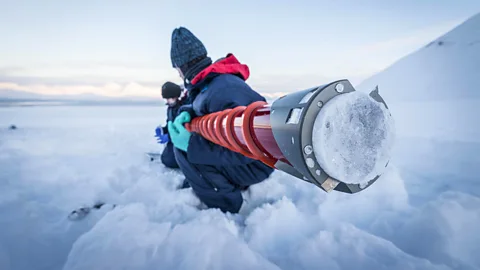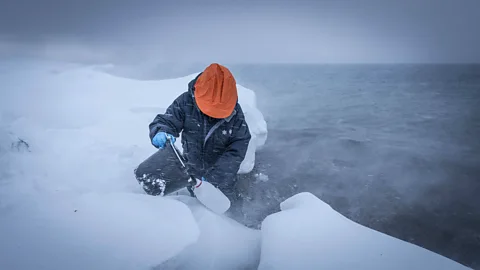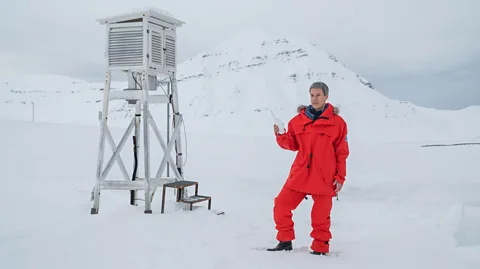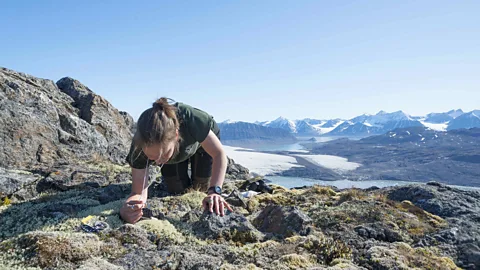Treading gently: The scientists who leave little trace at the world's northernmost lab
 Iain Rudkin
Iain RudkinScientists in the high Arctic are lifting their labs into the air to avoid damage from melting permafrost.
Ny-Ålesund in Norway's Arctic is the world's most northerly settlement. A team of scientists surrounded by glaciers, polars bears, walruses and arctic foxes call this hostile environment home while they're researching the Arctic's ice, ecosystems and atmosphere.
"The polar night is always the hardest," explains Marion Maturilli, a scientist studying Arctic climate dynamics with the French and German Polar Institutes, who is based at the station.
For more than 50 years, Ny-Ålesund has housed an international community at the top of the world just 1,200km (745 miles) from the North Pole. Remnants of scientific equipment from the mission which mapped the lines of longitude which define our time zones, still stand at Ny-Ålesund. More recently, Nasa used the base for its satellite lasers and measurements of the Earth's electrical field. Now, scientists from 10 countries live there to conduct their research. For almost three months at a time, they wake and go to sleep in darkness. Their experiments stretch from space to the mysteries of phytoplankton, microplastic pollution, walrus behaviour and alterations in Arctic cyclones.
 Iain Rudkin
Iain RudkinLeave minimal trace
The need to protect the unique polar archipelago resulted in the Svalbard Environmental Protection Act, which was one of the world's first international environmental protection agreements. But the impact left on this pristine landscape by the researchers is necessary, the scientists say.
Maturilli's team records long-term series of temperature and solar radiation measurements at Ny-Ålesund. Everyday for 30 years, the team at the German station used a weather balloon to raise a radiosonde – a small instrument which measures atmospheric conditions – which has to be carefully operated to prevent icing up in the clouds. The results are used to make accurate up-to-date weather forecasts but also document the long-term changes of temperature in the upper air of the region. These measurements depend on having precise and accurate reference points made at the station's high latitudes which give the global coverage and even our place in space.
"It doesn't sound spectacular but our daily measurements have produced reliable data for an international climate reference observing network," says Maturilli.
But to limit the impact of the settlement, only around 30 people are permitted live at the research station year-round.
"We do everything we can from planning to execution to change the Arctic as little as possible but this research is vital", explains Iain Rudkin, the Arctic Operations Manager for the British Antarctic Survey.
Efforts to mitigate their own environmental impacts are a high priority according to Geir Gotaas, leader of the Norwegian Polar Institute at the base.
Scientists are careful to collaborate to avoid any duplicated research. The teams on the base share data and boat rides to collect Arctic specimens and are planning to transition to electric snowmobiles – although there are challenges. "In the field researchers typically cover long distances and bring a lot of heavy equipment, and EV snowmobiles aren't up to the task – yet," says Gotaas.
Keeping the science on track
And, while protecting the rare ecosystem is enshrined in the Svalbard Treaty, the carbon footprint must also be limited so the science itself is not derailed.
"It's very important to limit our carbon footprint when we are working in such a unique environment", Maturilli says. She explains that if a car or engine snowmobile visits the atmospheric lab, the data for these periods is not usable due to the carbon increases. (Read more about why Ny-Ålesund is the town with the cleanest air in the world.)
 Esther Horvath
Esther Horvath"Worsened battery performance in cold conditions and any projects which involve sea or diving activities are very difficult because the logistics use up many resources," she adds. "We co-ordinate within the international community of climate researchers, each doing a puzzle piece to make sure we optimise activities so there's benefits for all".
The site has enabled long-term research in the high Arctic and unique collaboration between countries and disciplines. The scientists share equipment – everything from meteorologic balloons to second hand winter clothing.
The Korean Polar Institute's team is one such example of cross-country collaboration. The team used results from a project carried out by a German-Nordic partnership. The work led to the Korean team publishing a paper about how Arctic ecosystems operate during the dark.
Yoo Kyung Lee from the Korean Polar Institute says she also minimises her carbon footprint at the station by freeze-drying her plant samples to transport back to South Korea for further energy-intensive experiments. The frozen samples show the multi-generational changes in Svalbard's plant life. From the base, she monitors changes in the plants – creating DNA markers to distinguish populations and later sequences their genomes so she can study their adaptations to the changing climate.
In addition the Norwegian and Italian bases are collaborating in the Ice Memory operation, collecting cores to preserve these rich records before they disappear. The cores are sampled as twins, one being used for research and the other sent for preservation meaning that future generations of scientists can access high-quality cores to study the environmental conditions of our planet long after glaciers may have disappeared due to global warming.
 Iain Rudkin
Iain RudkinAt the busiest times for conducting research in the summer when the sun never sets, the population still remains less than 200, with food and waste strictly managed. The researchers eat the same meals as each otherin only one room to limit the container ship deliveries and the waste generated is sorted in 10 to 15 fractions – fractions is the term for waste categories such as food, cardboard, glass – and shipped to the Norwegian mainland for recycling
The majority of the produce comes from Norwegian wholesale suppliers and is imported from the mainland as there is no agricultural produce in Svalbard. Gotaas says they try to keep food waste at a minimum.
"The most important step is quite simple; only prepare the amount of food needed to feed the number of people in Ny-Ålesund at any given time," he explains.
Leftovers are typically served as part of lunch the following day and whatever is left of food waste is shipped to the Norwegian mainland for composting and regular waste handling.
While undertaking their projects, scientists regularly receive spot check visits when their power usage is scrutinised – with use of electronic devices limited to conserve electricity. The power station which provides electricity and hot water still runs on diesel, although heat exchangers have been installed to extract as much heat and energy as possible from the power generator exhausts. Smaller measures are also implemented, such as installing more efficient ventilation systems in the labs, switching from regular light bulbs to LED lights, having motion sensors to switch off lights automatically, and lowering of the temperature in rooms that are not being used.
Research instruments themselves are meticulously tracked across this remote landscape – each registered in a Geographic Information System (GIS) layer – or collection of geographic data – with every project's tools mapped and constantly updated. The general rule is that all projects should have a start and end date so that instruments no longer active are quickly collected, explains Gotaas. Because of the need to provide environmental data of the highest quality possible, Geir says it is in "everyone's interest to keep the local carbon footprint at a minimum to avoid any disturbance to the sensitive measurements".
A necessary presence
The stations themselves are as vulnerable as the ecosystem. The buildings, which function as both living quarters and laboratories were built as early as 1910, though to the 1960s.
Improving insulation is a step typically taken when renovating the old buildings. But since many of the oldest buildings in Ny-Ålesund are protected as cultural heritage, there are limits to what changes can be made. So, the scientists focus on improving efficiency and have installed the heat exchangers for this purpose.
But due to the melting permafrost, the stations are shifting and tilting with doors no longer fitting their frames, and pools of water are rotting their wooden foundations. To tackle this problem, the teams devised an engineering method to move the stations using car jacks to raise and then lower the buildings on new steel girded frames. In some cases engineers must drill 50m (164ft) deep into the bedrock and reinforce concrete pillars which have replaced the original wooden supports.
Carbon Count
The emissions from travel it took to report this story were 0kg CO2. The digital emissions from this story are an estimated 1.2g to 3.6g CO2 per page view. Find out more about how we calculated this figure here.
When the station was first built, the permafrost was so stable that this wasn't necessary, but with the changes from global warming over the last decades causing thawing permafrost several of the old buildings have extensive damages as the structural integrity has been compromised. Geir says that inserting steel pillars into the bedrock will "prevent damages from occurring, and reduce the need for expensive maintenance and reparations".
Two or three people can pull the entire building off its foundations, simply cut its electricity for half an hour and then reconnect it with none of the ongoing lab research compromised. With the Italian station already moved, the UK station is next in line in spring.
A race against time
Svalbard is the fastest warming place in the world, and even within the Arctic. Leaving as little trace as possible is a challenge for the whole Ny-Ålesund community. Now, not only the results but the research itself is being outpaced by the climate crisis as it becomes more seasonally dependent.
Until recently, scientists hoping to study the sea ice in the Arctic could research at the station but the presence of sea ice can no longer be guaranteed. "Normally now it is too warm and turbulent for the sea ice so we've had to turn down some projects otherwise the scientists could lose their funding," explains Rudkin.
The work that takes place on the research base informed the Intergovernmental Panel on Climate Change (IPCC) report that the Arctic is likely to be nearly ice-free in the summer before 2050, with Arctic sea ice cover already at its lowest level since at least 1850. And if scientists cannot research this sea ice, Rudkin worries about what will be lost to science.
"It's incredibly sad. Over 15 years, I've seen it change too much. [The] mind-blowing scenery gets under your skin and you fall in love with it. But I have two small kids and the thought of what world I'm leaving behind for them is always on my mind," Rudkin says.
"In daily life I meet people who ask me if the Arctic is actually changing," says Rudkin. "I wish they could see how much its lost so quickly. We always hope our science gets fed into policy so we could still change the future."
--
For essential climate news and hopeful developments to your inbox, sign up to the Future Earth newsletter, while The Essential List delivers a handpicked selection of features and insights twice a week.
